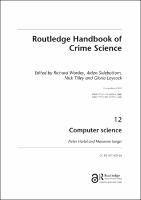Chapter 12 Computer science
Proposal review
| dc.contributor.author | Hartel, Pieter | |
| dc.contributor.author | Junger, Marianne | |
| dc.date.accessioned | 2019-10-17 14:28:11 | |
| dc.date.accessioned | 2020-04-01T10:30:14Z | |
| dc.date.available | 2020-04-01T10:30:14Z | |
| dc.date.issued | 2019 | |
| dc.identifier | 1004894 | |
| dc.identifier | OCN: 1100537128 | en_US |
| dc.identifier.uri | http://library.oapen.org/handle/20.500.12657/25198 | |
| dc.description.abstract | In this chapter we will explore the relationship between crime and computers and networks by answering the following questions: •• Which techniques from computer science can be used to prevent crime? •• Which techniques from computer science can be used to study crime? To address the first question we use the 25 techniques of situational crime prevention to provide a systematic assessment of how computer and network technology can be used to prevent crime. The second question will be addressed by discussing computer simulation methods in cases where real experiments with crime prevention would be too costly or impractical. | |
| dc.language | English | |
| dc.relation.ispartofseries | Routledge International Handbooks | |
| dc.subject.classification | thema EDItEUR::U Computing and Information Technology::UY Computer science | en_US |
| dc.subject.other | crime | |
| dc.subject.other | computers | |
| dc.subject.other | networks | |
| dc.subject.other | computer science | |
| dc.subject.other | crime prevention | |
| dc.title | Chapter 12 Computer science | |
| dc.type | chapter | |
| oapen.relation.isPublishedBy | 7b3c7b10-5b1e-40b3-860e-c6dd5197f0bb | |
| oapen.relation.isPartOfBook | fe73b562-84db-4e34-9aff-d54dc37eb1d3 | |
| oapen.relation.isbn | 9780203431405 | |
| oapen.imprint | Routledge | |
| oapen.pages | 13 | |
| oapen.remark.public | 3-8-2020 - No DOI registered in CrossRef for ISBN 9780415826266 | |
| oapen.identifier.ocn | 1100537128 | |
| peerreview.anonymity | Single-anonymised | |
| peerreview.id | bc80075c-96cc-4740-a9f3-a234bc2598f1 | |
| peerreview.open.review | No | |
| peerreview.publish.responsibility | Publisher | |
| peerreview.review.stage | Pre-publication | |
| peerreview.review.type | Proposal | |
| peerreview.reviewer.type | Internal editor | |
| peerreview.reviewer.type | External peer reviewer | |
| peerreview.title | Proposal review | |
| oapen.review.comments | Taylor & Francis open access titles are reviewed as a minimum at proposal stage by at least two external peer reviewers and an internal editor (additional reviews may be sought and additional content reviewed as required). |

